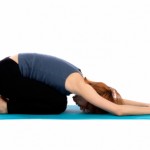 By Dr. Paul Jerard, E-RYT 500, YACEP
By Dr. Paul Jerard, E-RYT 500, YACEP
Where does shoulder tension come from? Whether it is from sitting at the computer all day, a difficult workout routine or just day-to-day activity and stressors, many people hold tension in their shoulders. It may feel like the side of the neck is actually getting shorter. In fact, it is often the levator scapulae, the muscle that attaches the shoulder blades to the neck, tensing up and pulling in an uncomfortable manner. However, this tension can be alleviated and eliminated through a Yoga routine.
Yogic Breathing – Pranayama
The breathing pattern changes when people are experiencing physical or mental stress. As a result, the breathing usually becomes more shallow and tense. Instead of breathing from the belly, people will start to take quick breaths from the upper chest. Nonetheless, the result is oxygen deprived muscles, which tire quickly and tense up often.
Results of Neglect
While this will eventually occur to all the muscles in the body, it is especially true for the muscles in the chest, and shoulders, because they are used for this improper breathing technique. However, by changing the breathing pattern through Yogic breathing (pranayama), even for just a half an hour a day, those muscles will receive a break. In other words, with regular Yoga practice, the body can also retrain itself to breathe this way throughout the day.
Yoga Posturing – Asana Practice
Yoga poses (asanas) work to release tension in the shoulders in a couple of different ways. Firstly, specific Yoga poses stretch the muscles around the shoulders. Secondly, by stretching the muscles, the shoulders can return to their original state of relaxation, and even gain some extra length, to prevent future tension. Postures, which will relax the muscles in the shoulder area, are Extended Child’s Pose, Half Downward Dog Pose, and Ardha Utkatasana (Half Chair Pose).
How to Strengthen the Shoulders
Strengthening types of Yoga asanas, such as Downward Dog Pose and Dolphin Pose, balance and stabilize the muscles around the shoulders. Thus, by strengthening the muscles, injuries can be prevented. Sometimes, people experience pain in their neck and shoulders and attribute it to stress, when it is actually a tear or joint problem. In such a case, medical advice should be sought. Non-surgical solutions may be possible, but one cannot forcefully exercise through joint problems.
Results of Proper Shoulder Posturing
Those, with chronic shoulder tension, can benefit greatly from incorporating Yoga into their daily routine. Some choose to take time out of their day to do a complete session before or after work, while others perform various postures throughout the day. Over time, Hatha Yoga practice will create a noticeable difference in the flexibility and strength within the neck and shoulders. With a little more awareness, one will improve overall posture, which will, in turn, reduce pains and aches.
© Copyright – Aura Wellness Center – Publications Division
To see our selection of Online Yoga teacher training courses, please visit the following link.
https://aurawellnesscenter.com/store/
Are you interested in Meditation Teacher Training?
Click here to see our online Yoga Nidra teacher training course.
Are you an experienced teacher looking for YACEP credits or continuing education?
Subscribe to Our Newsletter for Special Discounts and New Products
Related Resources
52 Essential Principles of Yoga Philosophy to Deepen your Practice
by Rina Jakubowicz
A Relaxing Way to De-stress, Re-energize, and Find Balance
by: Gail Boorstein Grossman
YOGA: THE PATH TO HOLISTIC HEALTH
by B.K.S. Iyengar
TEACHING YOGA: Essential Foundations and Techniques
Yoga Poses for Tight Shoulders
See our testimonials to find out what our graduates have to say about our selection of online yoga teacher training intensive courses.

Yoga asanas stretch the muscles and by this way the shoulders can return to their original state of relaxation, and even gain some extra length, to prevent future tension. Thanks for sharing this nice article.
Through Hatha Yoga practice with a little more awareness, one can improve overall posture, which will, in turn, reduce pains and aches.